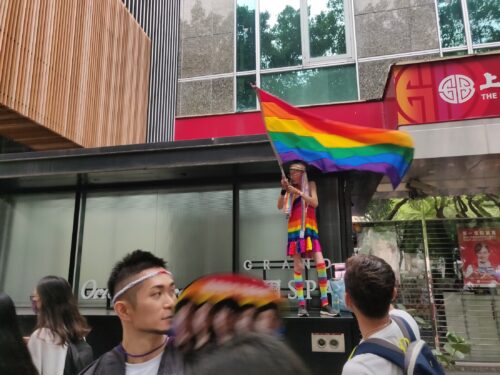Feminists and LGBTQ activists at China’s COVID protests
A feminist and an LGBTQ activist speak out about the A4 protests inside and outside China — how they sparked divisions, misogyny, and violence, but also hope and solidarity.

The string of protests that swept China at the end of November, considered the biggest in decades, seem to have ended positively, with the government recently moving to loosen its strict COVID policy.
These protests did not represent a united front with one clear aim, but a clutch of different people with a variety of different goals. The China Project here focuses on the protests from a feminist and queer perspective, interviewing one feminist and one queer activist, respectively living in China and Canada.
Inside China
Wáng Píng 王萍 — a pseudonym — is a feminist activist living in China. She talked of the bravery of the lone demonstrator at Beijing’s Sitong Bridge (四通桥) on October 13, whom she believes was just as important in triggering the protests as the fire that killed at least 10 in Ürümchi on November 24. The demonstrator draped a banner over the bridge, criticizing China’s COVID-zero policy and calling for democratic elections. The person, later called the “bridge man,” was immediately detained, but the slogans on his banner were widely circulated on the Chinese internet. “His words resonate with many people, including me. But our urge to voice these demands was only getting stronger after he broke the silence,” Wang said.
Wang emphasized the leading role played by young people, especially university students, in these protests: “People outside of China often have this impression that there’s no dissent in China,” she said. “But the recent series of events have proved that they underestimated how courageous Chinese people, especially young people, could be.”
According to news reports, several events occurred on university campuses, where students railed against school administrators after going through long periods of strict lockdown.
Women and LGBTQ people were among the student protesters. After the Sitong Bridge demonstrator was arrested, one of Wang’s female friends was inspired to put up posters with similar themes in public washrooms, which are considered relatively safe due to the absence of security cameras. But she was eventually tracked down and arrested by local police. With the full knowledge of the risks they were taking, many of Wang’s other women and LGBTQ friends still chose to take to the streets and join the rallies when they heard that protests were breaking out in their cities. “When you are truly concerned with these social issues, you would naturally go and join,” she said.
Wang noticed differing attitudes on how far the protests should go. When some started to shout demands calling for Xí Jìnpíng 习近平 and the CCP to step down, others tried to stop them. But in her opinion, this isn’t evidence of a lack of political consciousness, but more about the crowd’s reluctance to take unnecessary risks, noting that the protests were so brief and spontaneous that “it was difficult to fully unpack” what exactly they wanted. “The people there were highly aware of the risks,” she added. “But they still wanted to stay on the street as long as possible, so that it would be reported by the media and make a change to the policy.”
The protests were fleeting and decentralized, so Wang finds it hard to draw an overall evaluation of events. But she is optimistic, saying that she believes that the young people in those protests were not driven by “foreign forces” (境外势力 jìngwài shìlì) as the government claimed, but “by their conscience” (良知 liángzhī) and their care for each other.” As long as these values remain, she said, “we should have confidence in young people in China.”
Outside China
Beyond the Chinese borders, Juǎnjuǎn 卷卷, a queer feminist activist based in Canada, helped coordinate a public event in a Canadian city to honor the victims of the Ürümchi fire and open a dialogue about the situation in China. Juanjuan didn’t want to share her real name and the specific location of her city for her own safety.
She agreed with Wang about the influence of the “bridge man” on the protests, saying that demonstrations felt powerful and contagious to her. Inspired, she even based the slogans chanted during her rally on the Sitong Bridge banner. At the protest she attended in Canada, she added three extra phrases (highlighted in bold below) to show solidarity for oppressed women and LGBTQ members in China:
“Stop watching and come join us (不要围观,请加入 Bùyào wéiguān, qǐng jiārù)! We want freedom, not lockdowns! Food, not nucleic act tests! Dignity, not lies! Reform, not Cultural Revolution! To be citizens, not slaves! Diversity, not patriarchy (不要父权,要多元)! Democracy, not totalitarianism (不要极权,要民主)!”
Juanjuan explained that she added the first phrase to mobilize people to participate, not just watch. The last two phrases added a queer and feminist perspective to the discussion about Chinese democratization. “Patriarchy and totalitarianism have equal significance. Neither should be prioritized in our struggle for social justice,” she said.
But these new slogans were challenged. “I believe we need men’s power at this moment, since we should struggle for our rights in a manly way,” said one man when attendees were invited to share their thoughts with the crowd. This comment, however, intrigued women and LGBTQ members, including a few originally from Xinjiang. One by one they came to the front, either opposing the comment or opting to share their personal stories and discuss the situation for queer people in China. “Do you mean only men are able to protest?” one person responded. Another person shared her story on how censorship affected her management of a social media account for the LGBTQ community.
“Their speeches highlight that activism should not be limited to a masculine imagination, as women and LGBTQ people have already been actively involved in social resistance in their everyday struggles. Our existence itself is a form of resistance,” Juanjuan said. She recalled that when she was leading the chant, the crowd was quieter when it came to “Diversity, no patriarchy,” signaling a general hesitance to engage with gender and sexuality issues.
Despite the divisions, Juanjuan believes the rally created a peaceful and inclusive space for people from different sides. It could have been worse: Conflict descended into physical violence in other cities, Juanjuan said, citing an incident at a gathering at Columbia University on November 28, where a woman was repeatedly punched in the head by a man before she lost consciousness and was sent to a hospital.
In a discussion on the Reddit website, a person who participated in similar rallies in Japan shared sexist and misogynist comments purportedly made by male members of some social media groups.
In response, groups of Chinese queer and feminist activists living abroad have developed guides and suggestions about how to ensure a safe and friendly environment for women and LGBTQ people when organizing demonstrations and protests.
Juanjuan believes there is a strong link between the increasingly visible queer and feminist voices in overseas rallies and LGBTQ and feminist activism within China. “We should keep in mind the dangers and obstacles faced by the domestic protesters,” she said. “Many of the activists in China don’t have the chance to speak out publicly. For those of us living overseas, we should use our fortunate situation to convey the specific demands made by Chinese protesters and help them change the status quo.”





